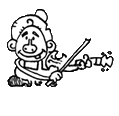Learning Notes on the Staff III – Low Second Finger
We will now learn to read the low second finger notes. This will allow you to read the D and A Dorian scales, as well as the upper octave of the G major scale.
{video}
Let’s start by playing the note name game for F natural with an F drone.
If there is no sign, then we assume that the note is natural. It needs no extra sign.
DL2

{F drone mp3}
Sometimes you’ll find both F# and F natural in the same bar. In that case, you’ll see this natural sign added to indicate F natural.
D2-2-L2-L2

{mp3}
Play the note name game by alternating between playing and saying the note names. Once it starts to flow, try to do it as you look at the sheet music snippet.
Now let’s play the Note Name Game on the first four notes of D Dorian. Alternate between playing D0-1-L2-3 and singing or saying the note names (D, E, F, G).
Now, alternate between playing and saying the notes, but look at the staff while you do it.

Cool! The next step is to play the game while looking at the staff without the note names.
- Alternate between playing the notes and saying the notes. Keep your eyes on the sheet music.
- If you can do that well, then try to play and say (or sing) the notes at the same time.
- Do this a little each day, and without much effort, your brain will have learned to read these notes on the staff.

How did that go?
Let’s review the note name game for C natural with a C drone.
AL2
{C drone mp3}
C natural is written like this:

Again, if there is no sign, then we assume that the note is natural.
Sometimes you’ll find both C# and C natural in the same bar. In that case, you’ll see this natural sign added to indicate C natural.
A2-2-L2-L2

{mp3}
Play the note name game by alternating between playing and saying the note names. Once it starts to flow, try to do it as you look at the sheet music snippet.
Further practice
Exercise 7
Now let’s read the first four notes of A Dorian (also the last four notes of D dorian). Alternate between playing A0-1-L2-3 and singing or saying the note names (A, B, C, D). Look at the staff while you do it.

Exercise 8
Cool! The next step is to play the game while looking at the staff without the note names.

Exercise 9
Combine these notes with those on the D string to make a D Dorian scale.

Exercise 10
Now read the notes without not names

Exercise 11
Finally, we’ll learn to read low second finger on E string, which is G natural. This will allow you to read an A Dorian scale as well as the upper octave of the G Major scale.
Let’s play the note name game for G natural with a G drone.
EL2

{G drone mp3}
Exercise 12
E2-2-L2-L2

{mp3}
Play the note name game by alternating between playing and saying the note names. Once it starts to flow, try to do it as you look at the sheet music snippet.
Exercise 13
Now let’s play the Note Name Game on the last four notes of A Dorian. Alternate between playing E0-1-L2-3 and singing or saying the note names (E, F#, G, A).

Now, alternate between playing and singing the notes, but look at the staff while you do it.
Exercise 14

How did that go?
Exercise 15
Now let’s read the entire A Dorian scale.
Exercise 16
Now let’s read the entire A Dorian scale WITHOUT note names.

Awwwwwsome.
Exercise 17
Now let’s read the entire G Major scale.
Exercise 18
Now let’s read the entire G Major scale WITHOUT note names.

ACTION: In your sheet music journal, write out the notes for D Dorian. Use a pencil with a good eraser handy. I recommend that you do NOT include fingerings or letter names. See if you can name each note.
ACTION: In your sheet music journal, write out the notes for A Dorian and G Major Upper Octave. Use a pencil with a good eraser handy. I recommend that you do NOT include fingerings or letter names. See if you can name each note.
Fun Fiddle Quiz
Now we’ll practice note reading with this fun fiddle quiz. Take it as many times as you like. The point is not to ace this, but to engage in active learning.


